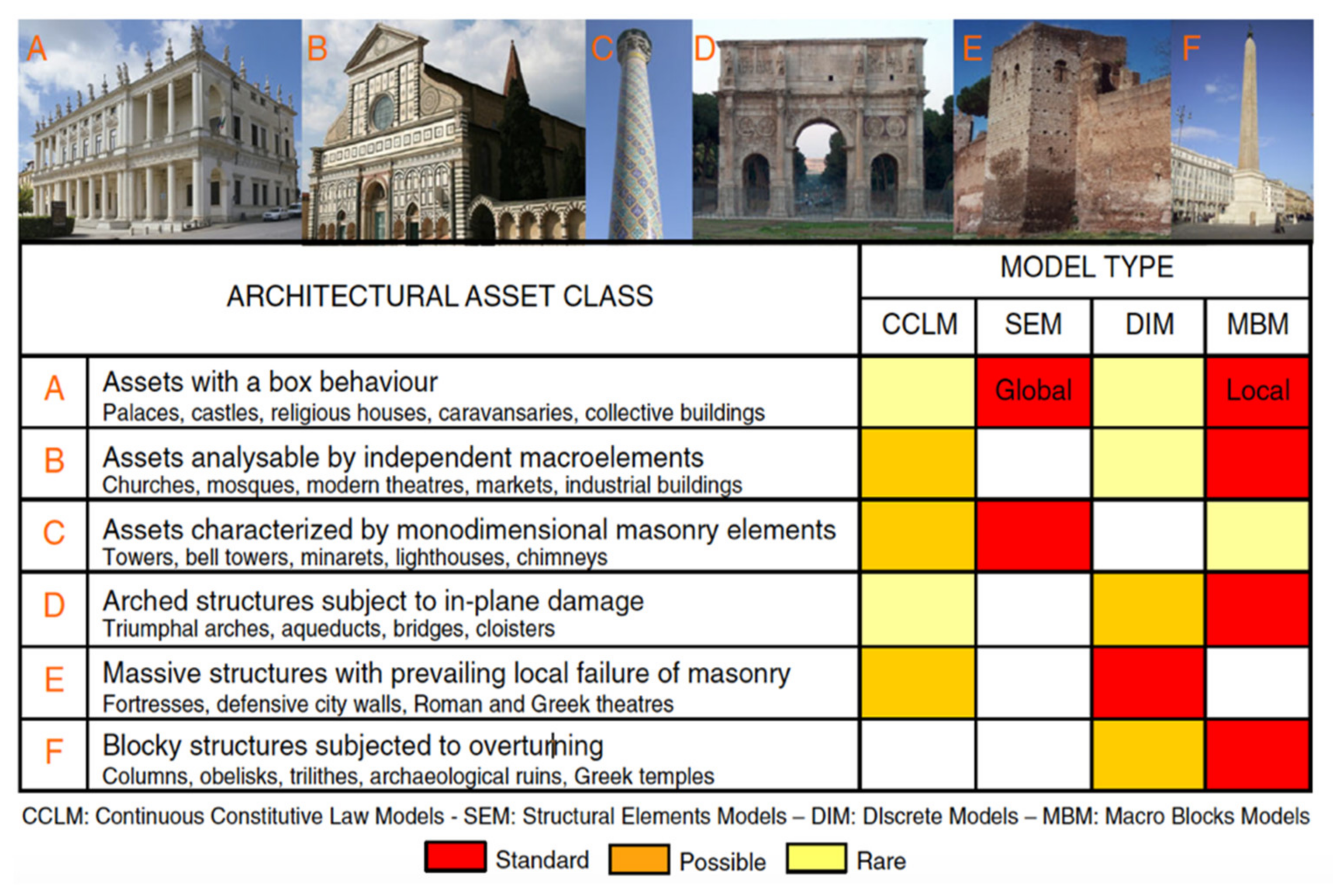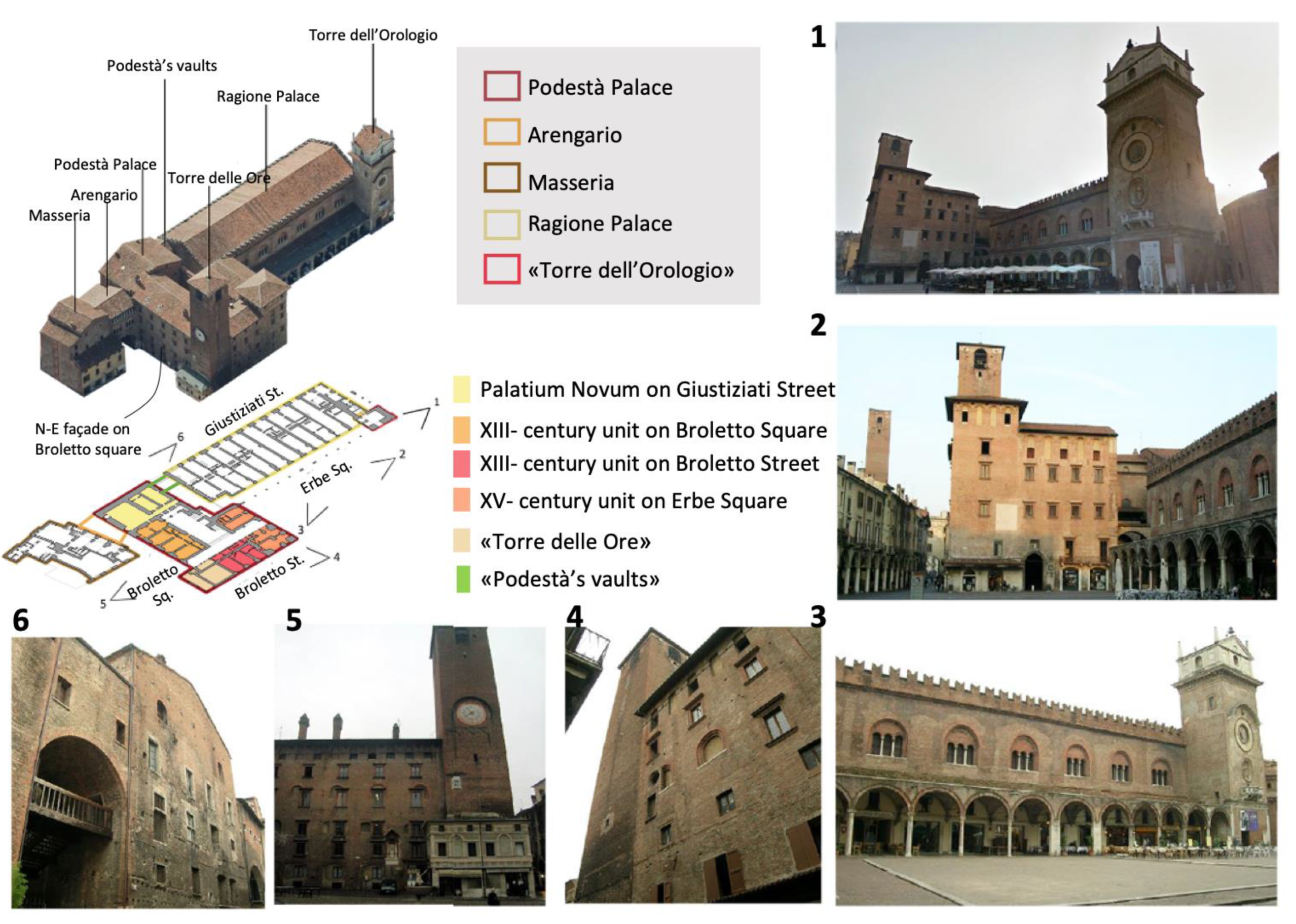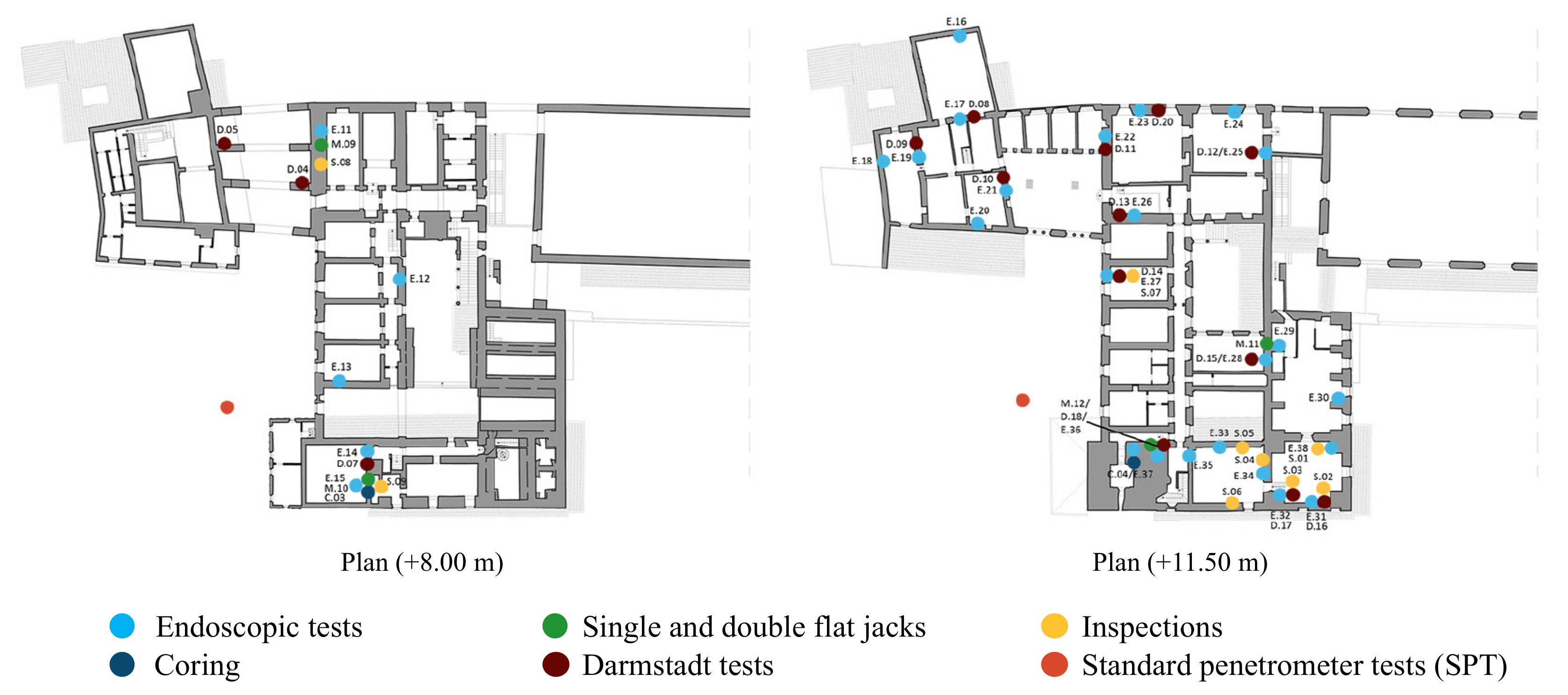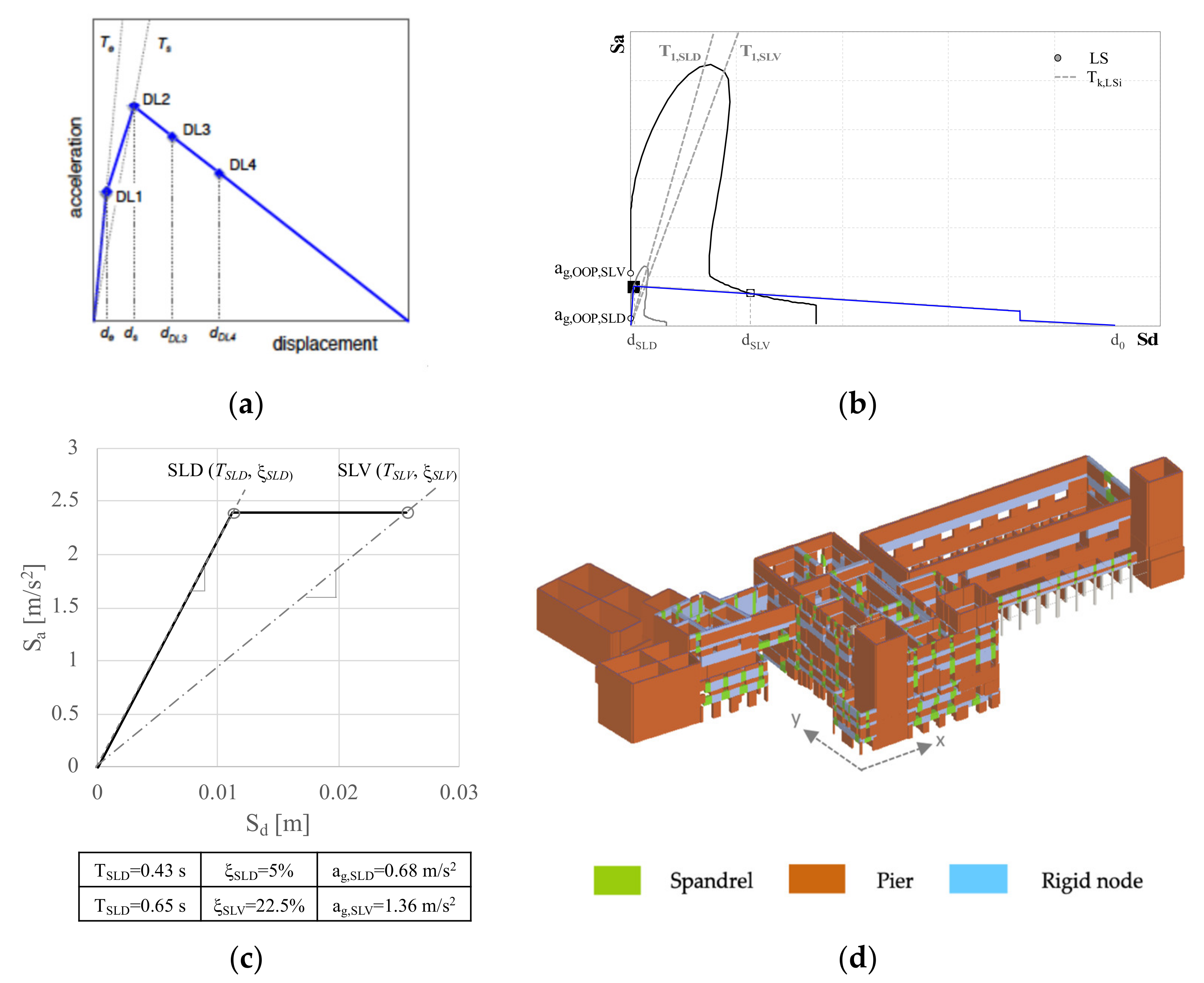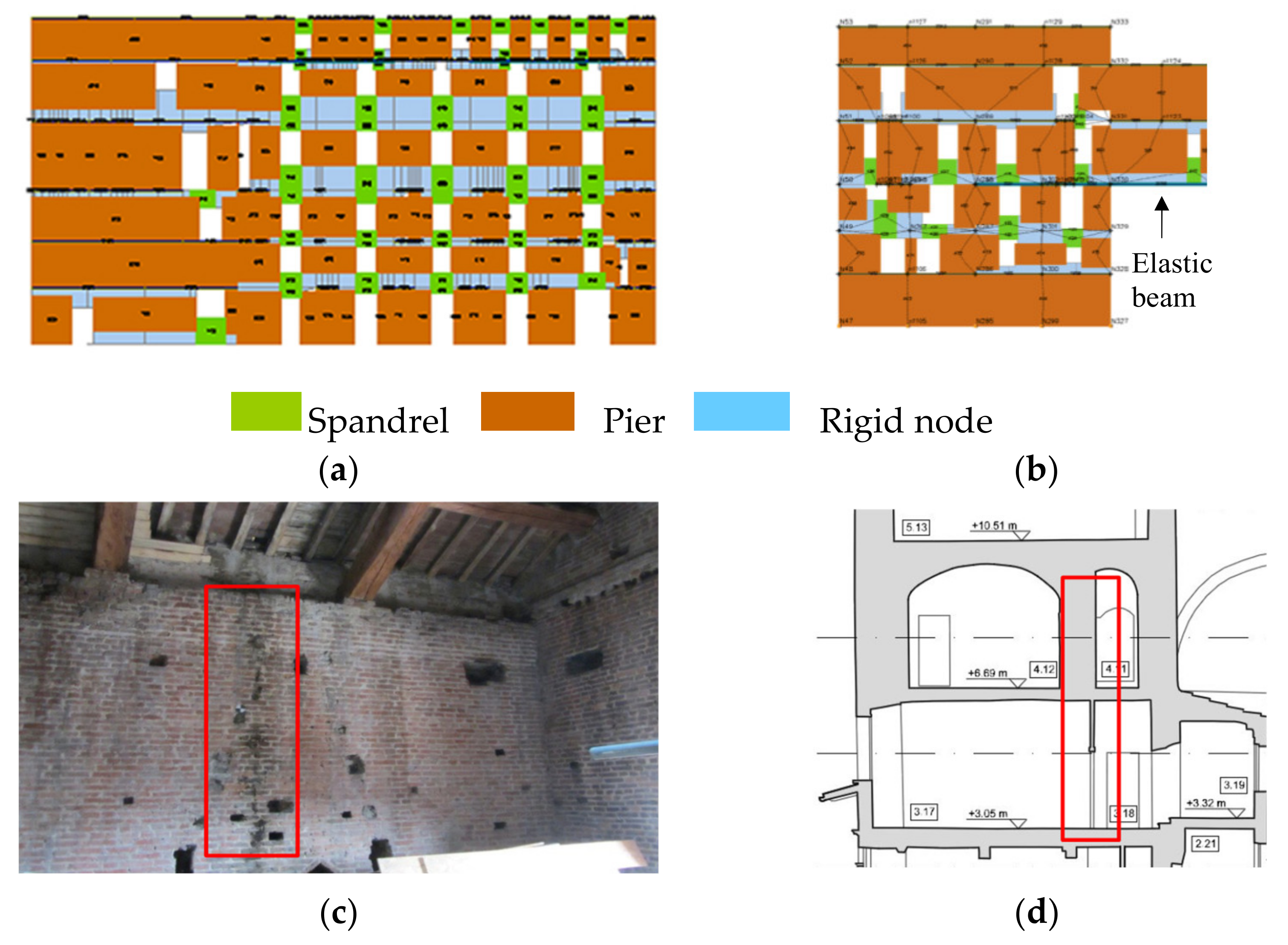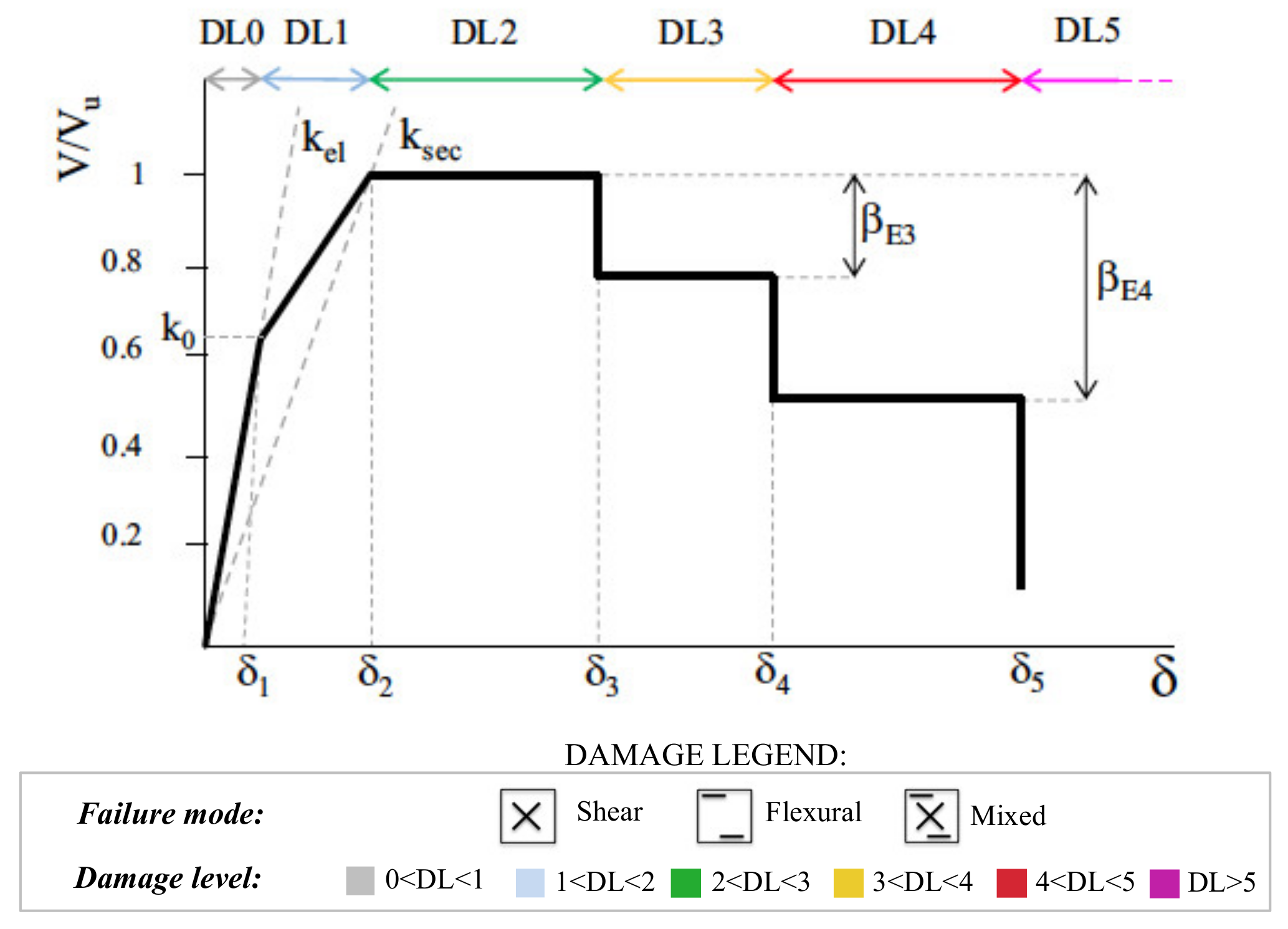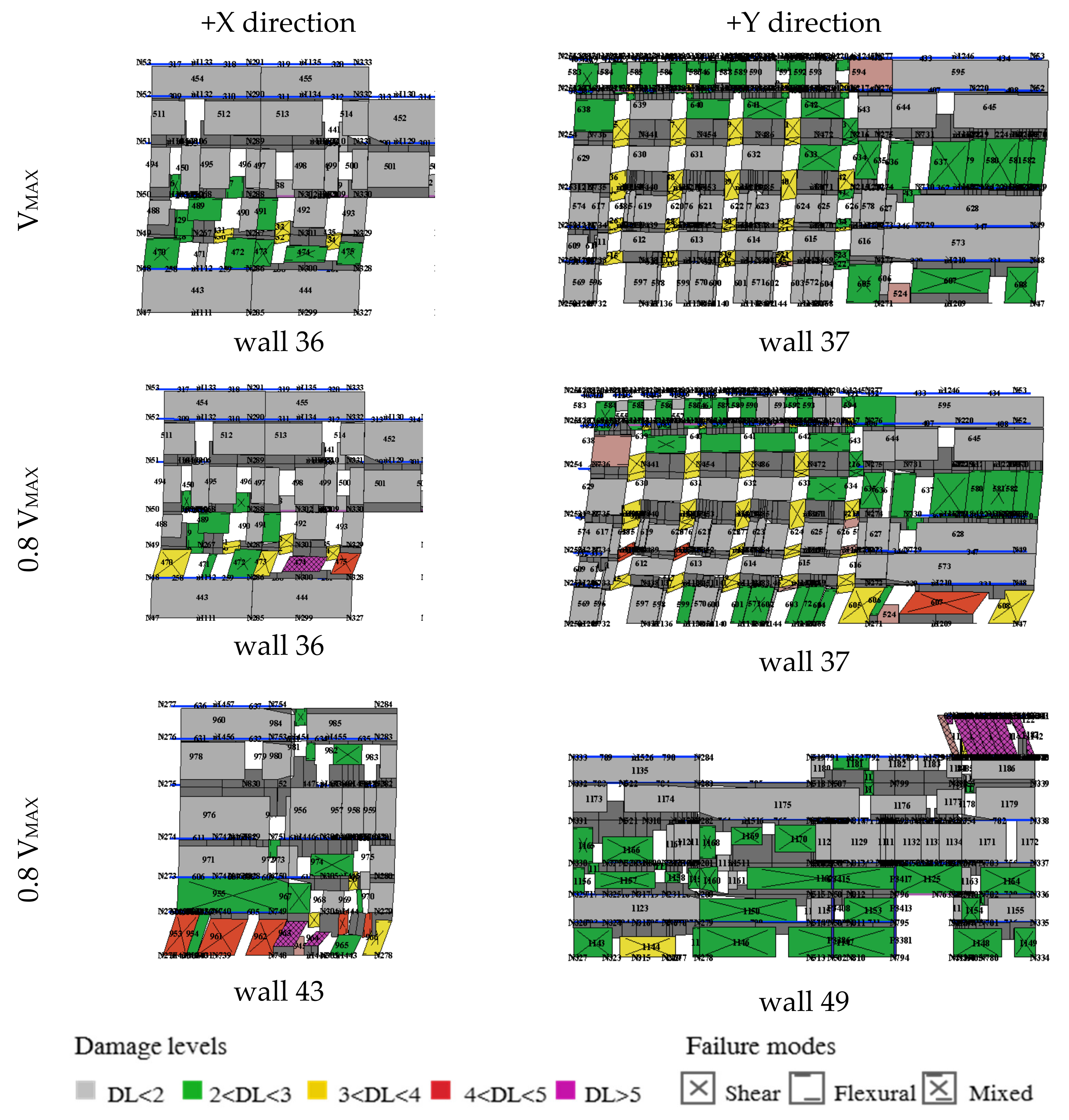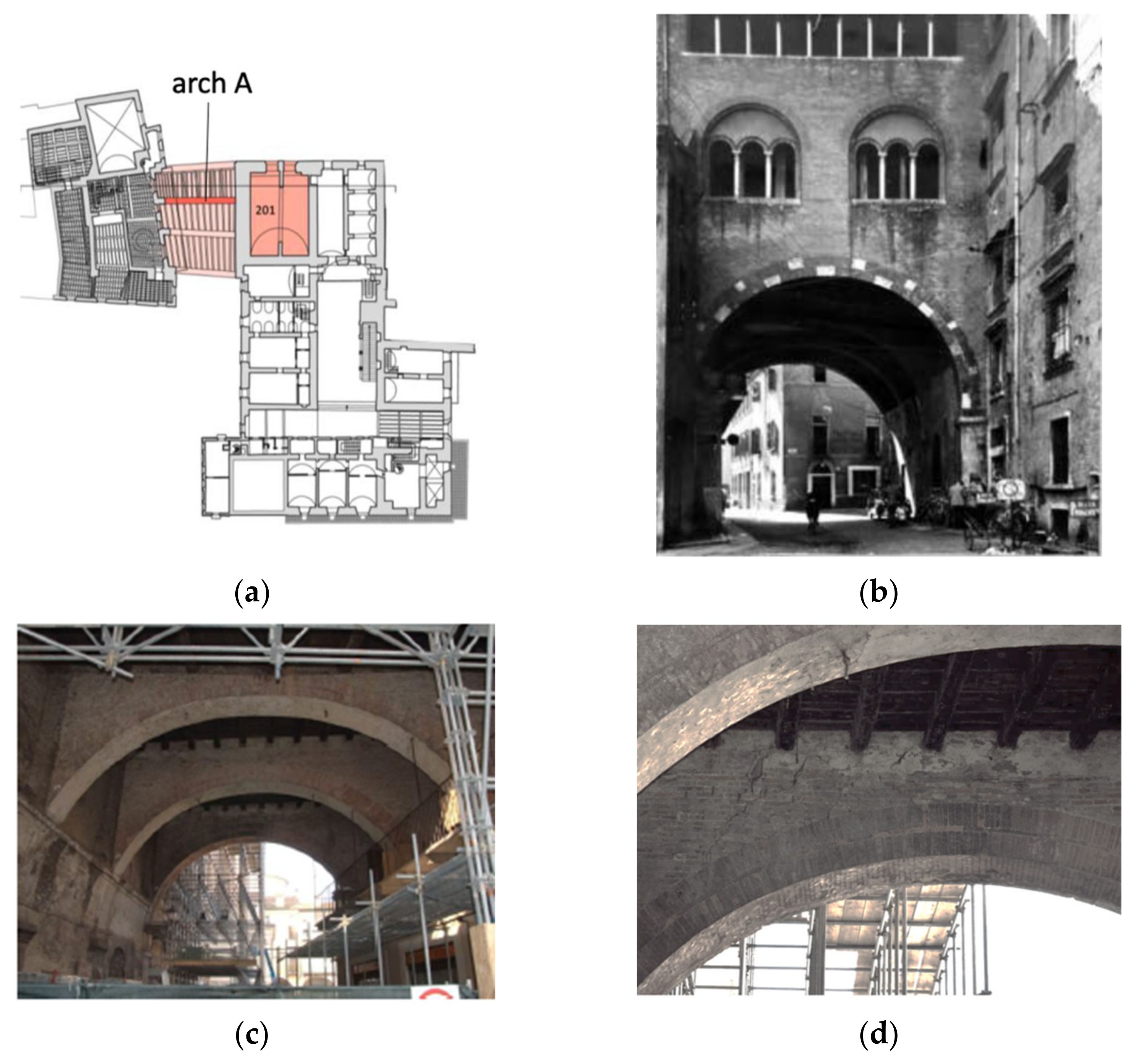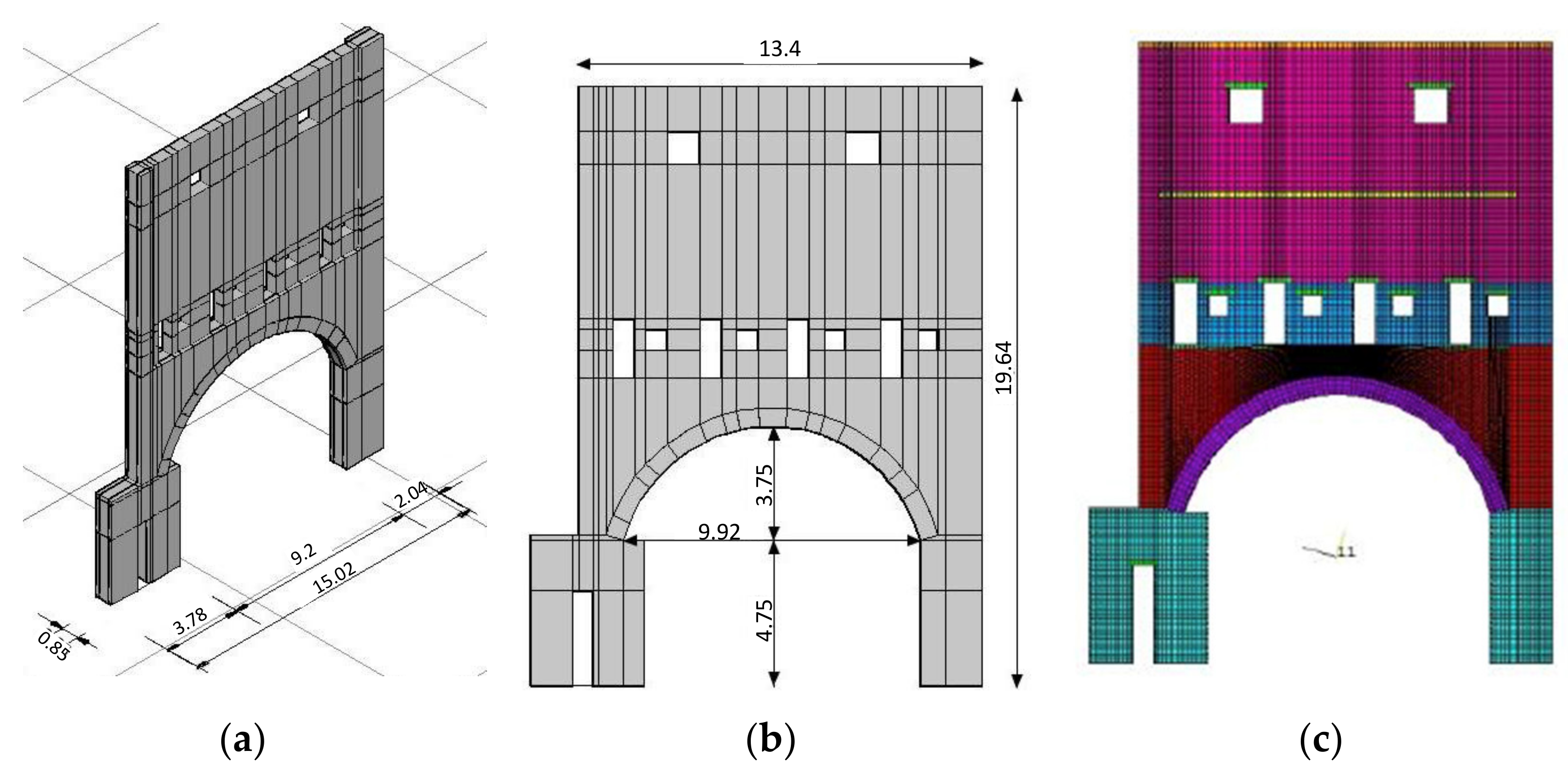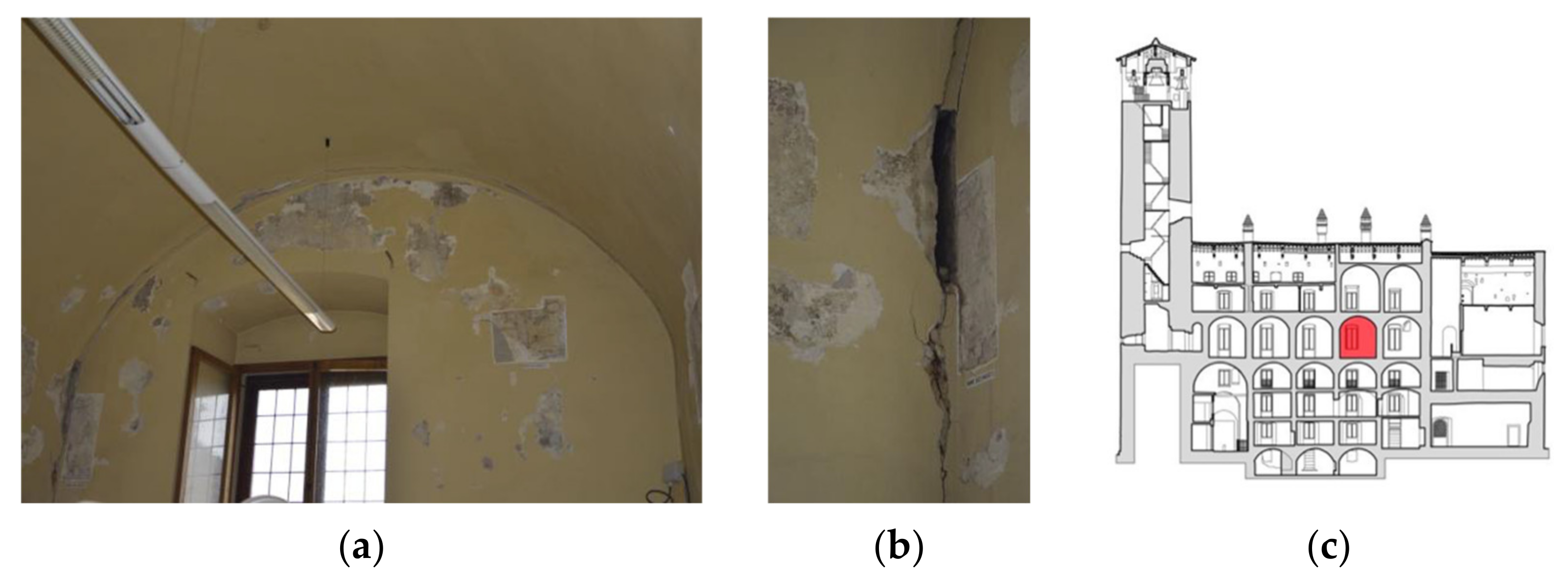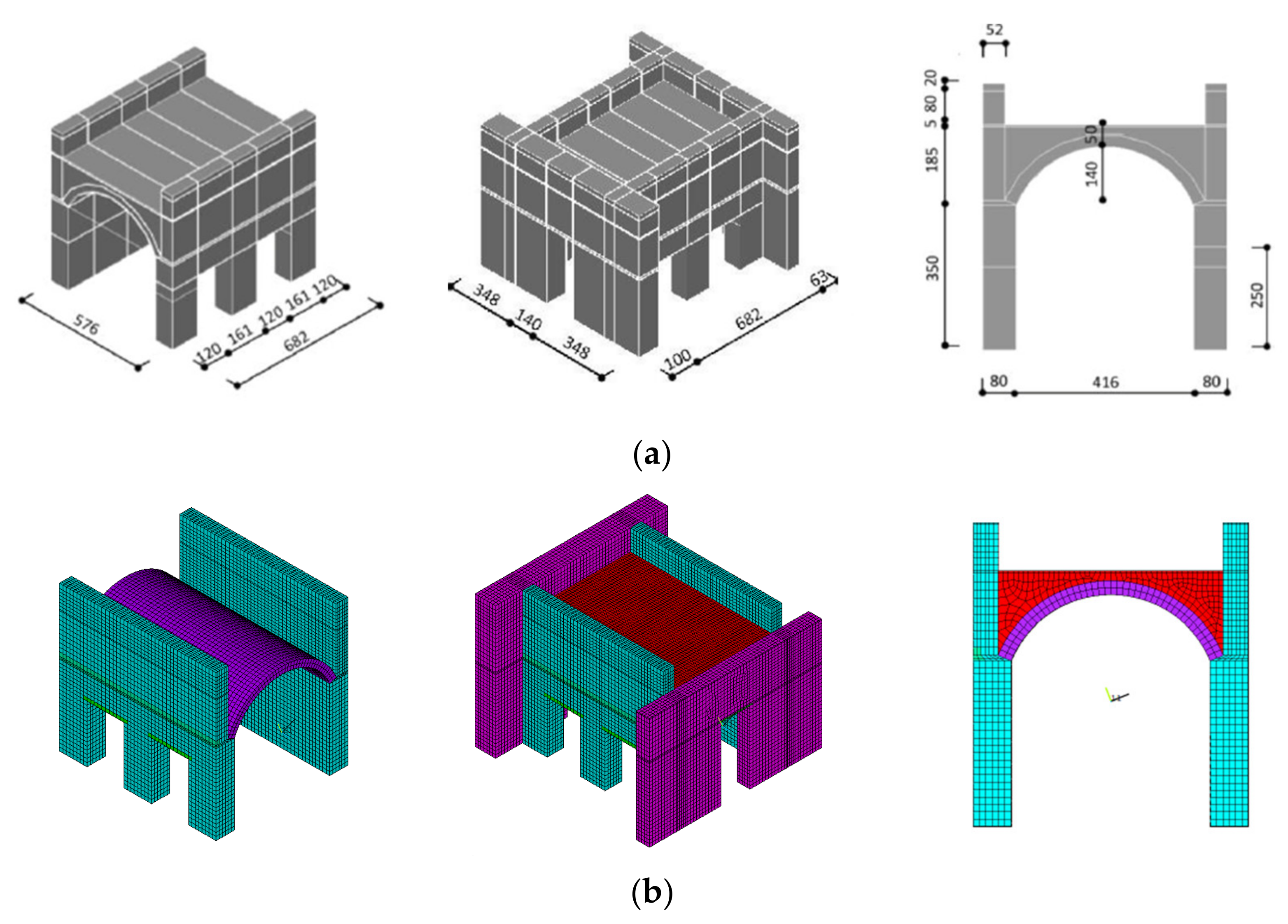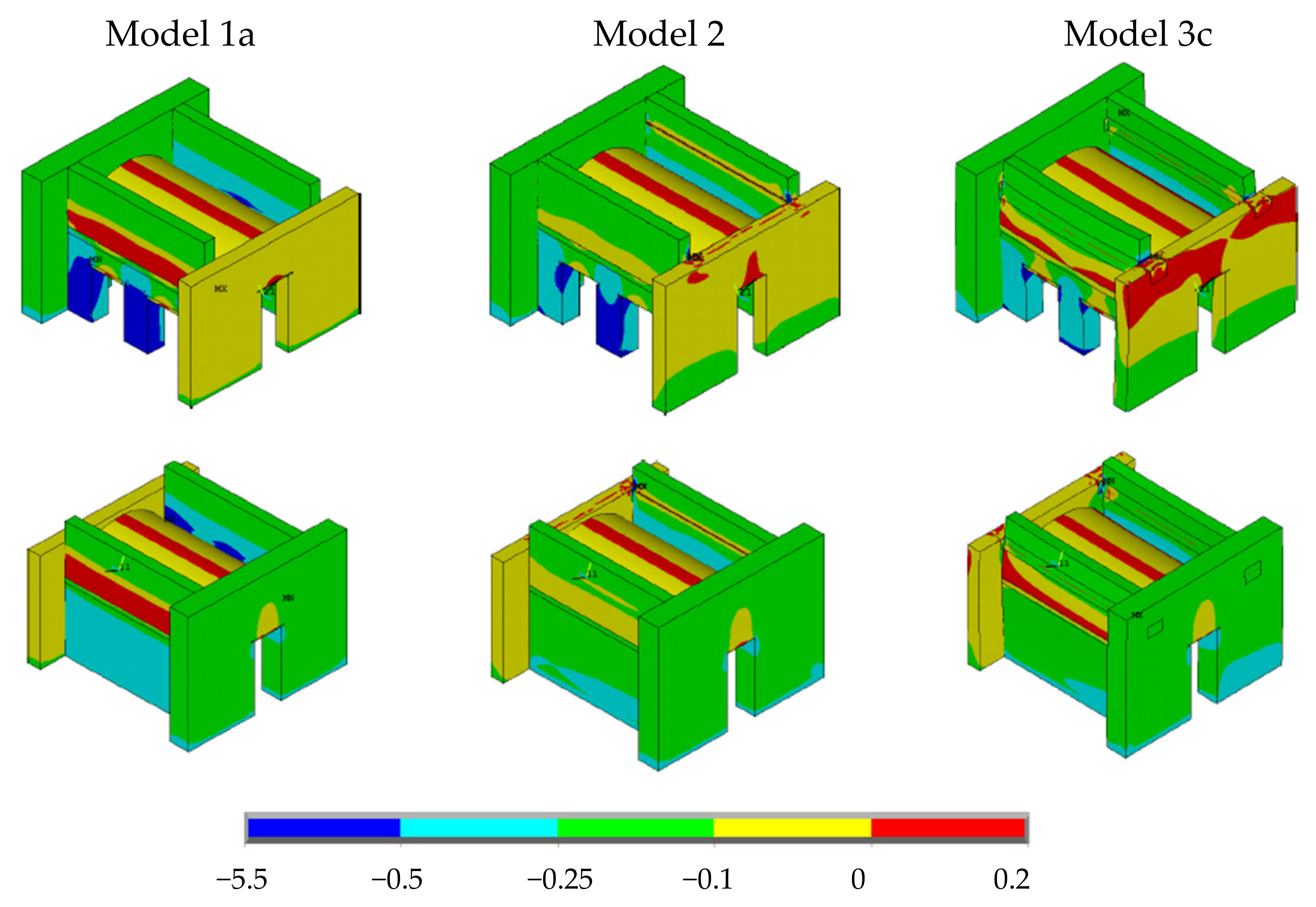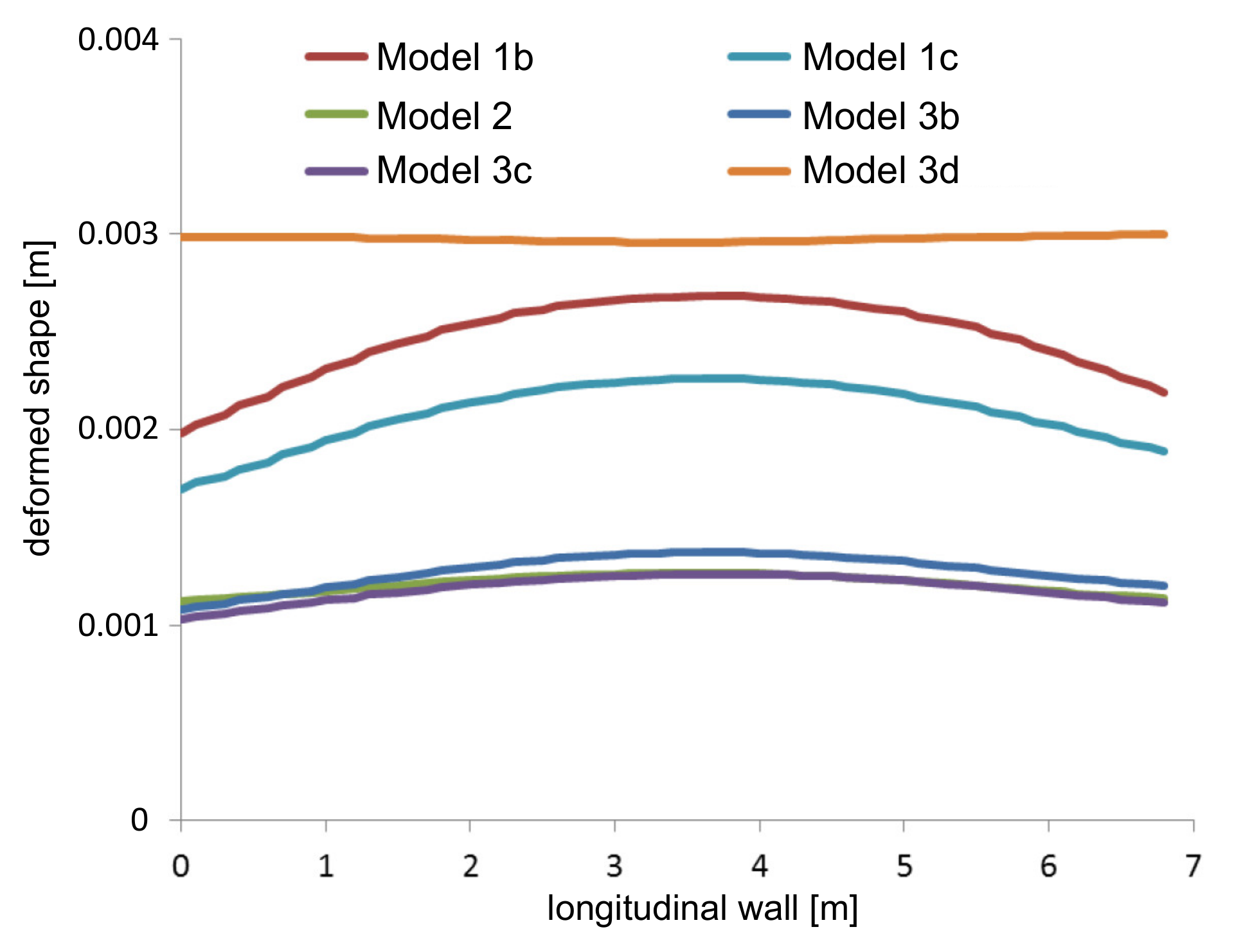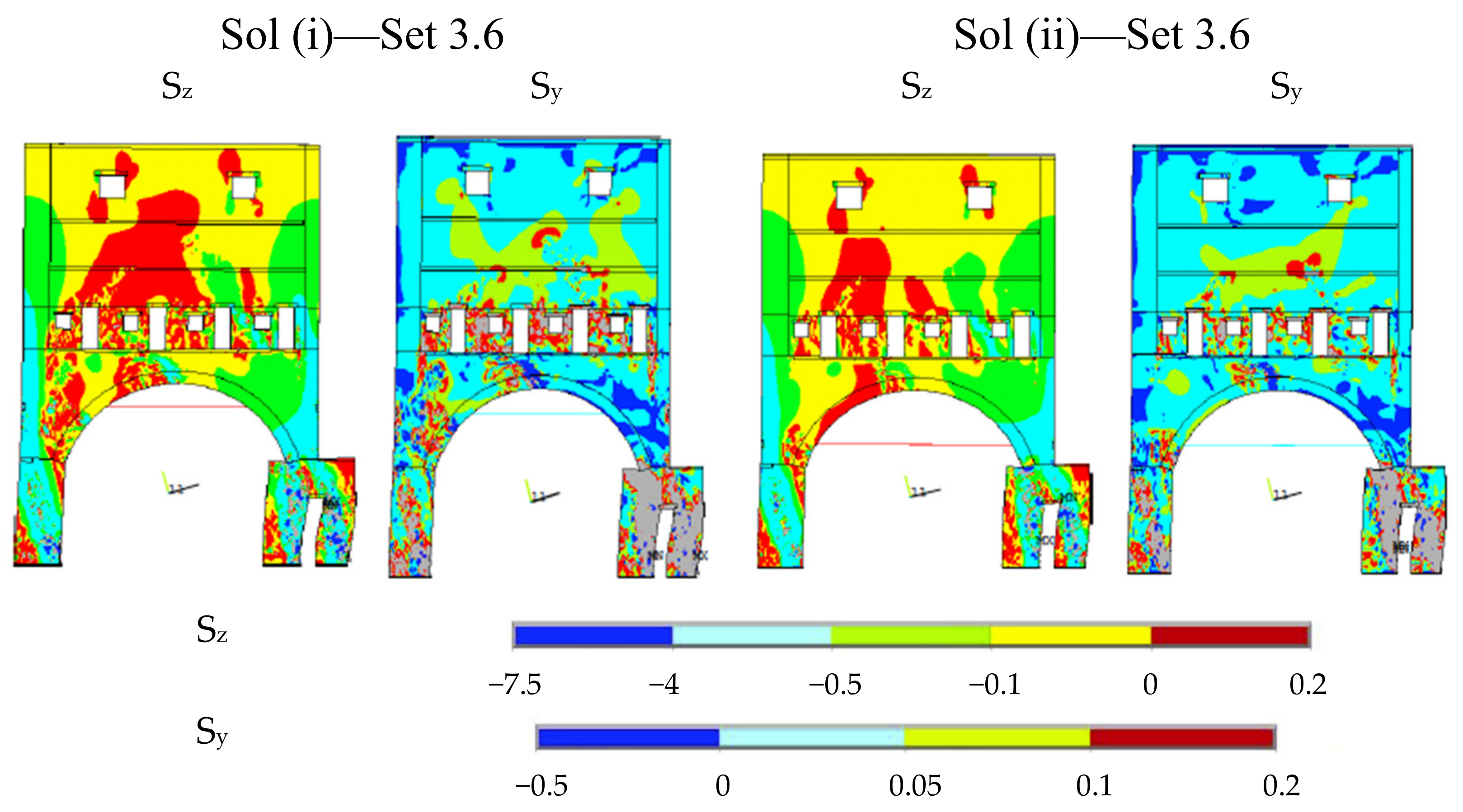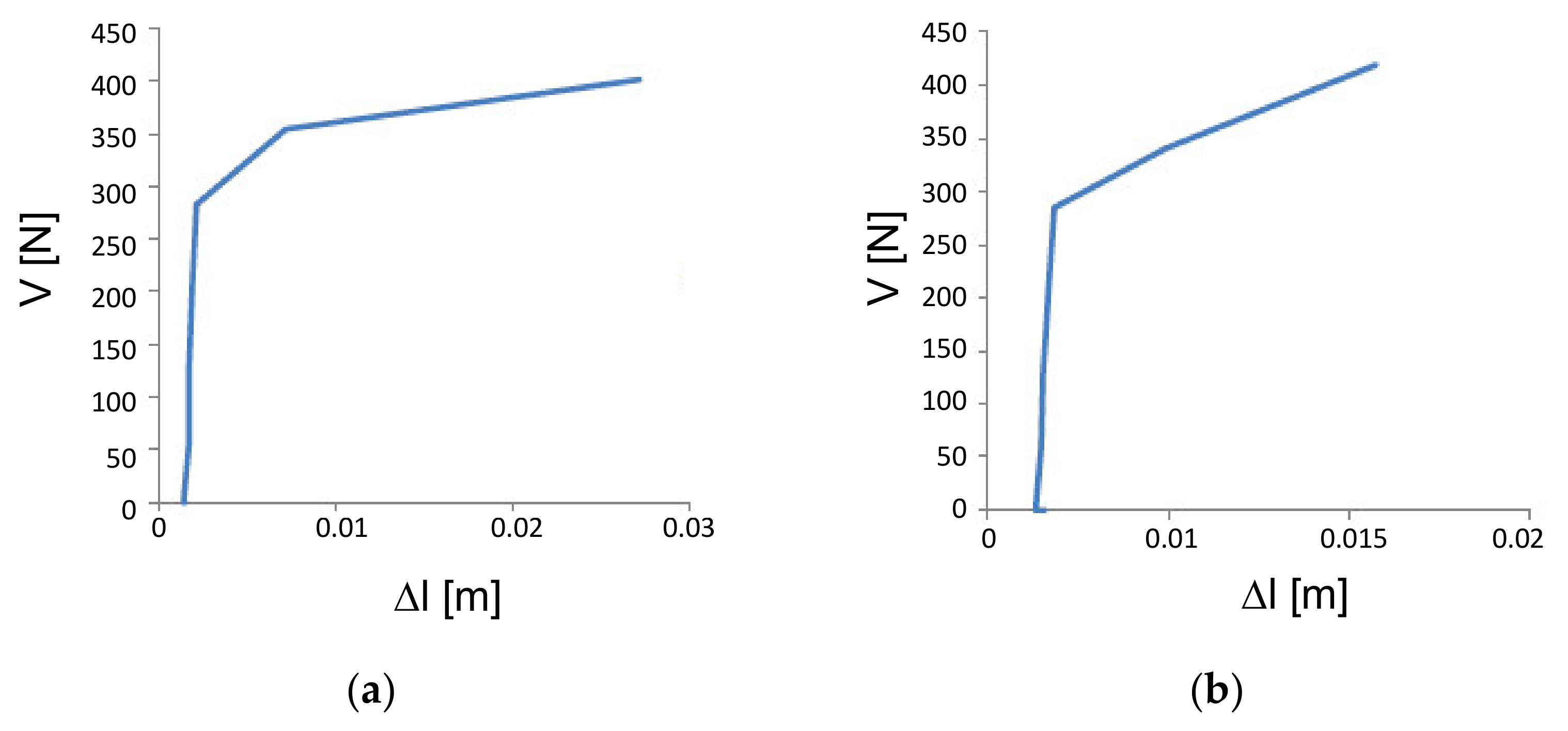4.1. Adopted Criteria for the Global Modelling by the SEM Approach
In order to explicitly consider the interactions between the different units of the palace, a SEM model of the whole complex building was set up. The model includes the main bodies object of the seismic assessment (i.e., the Podestà Palace and the Masseria), the adjacent ones (i.e., the urban aggregate close to the Masseria and the Ragione Palace), and the connection bodies (the Arengario and the Podestà’s vaults). The 3D model was realised using the 3Muri software [
46], based on the solver developed by [
47]; the research version of this software was then adopted to perform the nonlinear analyses. As already mentioned, the software package works according to the equivalent frame (EF) model approach (
Figure 7a).
According to the EF approach, only the in-plane response of the URM walls is considered, and each wall is discretised by a set of masonry panels (piers and spandrels), where the non-linear response is concentrated, connected by a rigid area (nodes). The wall idealisation into an equivalent frame is a tricky step. It affects both the elastic field, since it alters the actual deformability of the wall due to the simplification of introducing rigid nodes, and the nonlinear phase of the response, since the regions where the cracks and nonlinearity are likely to develop are assumed a priori. Despite these simplifications, this approach is one of the most spread both in engineering practice and at the research level thanks to its computational efficiency in performing nonlinear analyses (e.g., in [
48]) and its reasonable accuracy, as proven by various numerical simulations in the literature (e.g., in [
49,
50]). In the examined case, performing a complete model of the whole aggregate with other approaches, such as FEM, would have been almost unfeasible. Of course, when applied to monumental buildings, particular attention has to be paid to its correct use starting from the aforementioned EF idealisations of walls that may present various sources of irregularities (in the opening layout, in the heterogeneity of materials, in the discontinuities, etc.). An overview on the issue, including the repercussions of irregularities in the performance-based assessment, is presented in [
51]. Regarding the rules for EF idealisation specifically, although different criteria were proposed in the literature (e.g., [
1,
52,
53,
54]), no agreed rules have been unanimously yet recognised. Moreover, it was shown that, in general, the dispersion of the results increases with a pronounced irregularity in the opening patterns (e.g., [
55,
56]). Recent research ([
55,
57]), based on both numerical investigations and the analysis of the in-plane severe damage of real buildings, has highlighted that the criteria proposed in [
1] give quite reliable results: thus, they were here assumed as a reference. Moreover, in general, it was verified that, in the model, the rigid nodes were not too big to limit the alterations induced to the wall stiffness. By way of example,
Figure 7a shows the EF idealization of the façade overlooking the Broletto square.
Apart from that, the setup of the EF model requires great care and accuracy in transferring as much information acquired during the knowledge phase as possible into the model (as discussed for example also in [
27,
50]). Some critical situations (
Figure 7c,d) that may potentially reduce the strength and stiffness of structural elements (such as the presence of flues, recesses, infill openings, and non-continuous walls) were taken into account with specific expedients:
The flues and internal cavities were modelled as equivalent openings.
The recesses were modelled alternatively: directly as openings (with a height equal to the one detected during the in-situ inspections), if their thickness was higher than half thickness of the wall, or as URM panels with a thickness and height equal to those measured in loco.
All the buffered openings were modelled as URM panels with half the thickness of the original wall.
Elastic beams were introduced under all the non-continuous walls in order to allow a proper transferring of the actions at ground level through the adjacent elements (
Figure 7b).
Starting from the 2D modelling of walls, the complete 3D model was obtained by also introducing diaphragm elements, modelled as orthotropic membrane finite elements. The equivalent elastic moduli were calibrated according to [
40,
58,
59] for vaults and timber floors, respectively. The ability of the software to model flexible and stiff diaphragms as well is crucial for the building under examination, for which the adoption of rigid floors would be inadequate. A view of the global 3D model is presented in
Figure 5d.
Table 2 presents the mechanical parameters assumed to describe the response of URM panels; the latter correspond to the mean values of the range proposed in the Italian Technical Code [
17] for a masonry built with solid bricks and lime mortar. The adoption of these values was supported by the results of the available diagnostic techniques performed on the building (
Figure 3). Moreover, they are also consistent with the results of in-plane cyclic tests on masonry panels available in the literature (e.g., [
60,
61]).
The strength values were reduced by applying a confidence factor (CF) equal to 1.2. This value corresponds to that proposed in Codes [
15,
16] assuming the attainment of a level of knowledge KL2 and, as known, aims to conventionally account for the residual uncertainties in the final assessment. In fact, despite the quite accurate knowledge acquired on structural details, the KL2 derives from the limited in-situ investigations on the materials, reduced in number to limit the invasiveness.
Both a linear modal and a nonlinear static analysis were performed on the model.
In the nonlinear field, the piecewise-linear constitutive laws proposed by [
1,
48] and implemented in Tremuri software were adopted to describe the response of masonry panels. This constitutive law (
Figure 8) simulates the nonlinear response until very severe damage levels (from 1 to 5) are reached through progressive strength degradation (defined in terms of residual strength
βEi) in correspondence with the assigned values of drift
δEi; the latter are differentiated as a function of the different possible failure modes (e.g., rocking, diagonal cracking, bed joint sliding, or mixed modes) and of the element type (if spandrel or pier). The ultimate strength of URM panels is computed according to the strength criteria commonly proposed in the literature (e.g., discussed in [
62,
63]) and codes (e.g., in [
15,
16,
40]) for regular masonry, as that under examination.
Table 3 summarises the main parameters assumed in the nonlinear analyses for piers and spandrels. Drift thresholds are compatible with those indicated by recent databases that have collected the results of several experimental results [
60]. In the case of spandrels, the assumed residual strength is justified by the presence of an effective architrave; the value is compatible with those proposed in [
40].
4.2. Evidence from the Modal Analysis on the Interaction among Units
First of all, the modal analysis was performed to interpret the dynamic response of the whole palace. The results of the building in the original configuration (hereafter referred to as “flexible floors”) were compared with a stiffer one (hereafter referred to as “stiffer floors”), in order to evaluate the effects of a stiffening of the membranes on the global response. This stiffening aims to simulate the possible replacement of the original filler of the vaults (made by heavy incoherent materials and debris) with a new one, lighter but with non-negligible mechanical properties (see also
Section 6). Thus, the simulation of this intervention also produces a decrease in the overall mass of the model.
Table 4 shows the main results of the modal analysis in terms of period (
T), frequency (
n), and percentage of participation mass (%
Mx, %
My, and %
Mz). The results were illustrated by selecting the first 10 modes; the most significant ones in terms of participation mass are marked in grey. Although Mode 3 had >15% mass in the Y direction, it mostly activated the dynamic response of the Ragione Palace, which was not the main focus of the analyses; for this reason, Mode 3 is not highlighted in the table.
In general, it is possible to observe that the different units mutually interact in a very different way, considering the X or the Y directions. For example, in the Y direction, the Podestà Palace almost behaves as two distinguished bodies, i.e., the thirteenth-century unit overlooking the Broletto square and the fifteenth-century unit overlooking Erbe square. They are connected through highly flexible elements. Furthermore, the building overlooking the Giustiziati street strongly interacts with the Arengario and the Ragione Palace. Finally, the area overlooking the Broletto street is mostly affected by the interaction with the tower.
Figure 9 compares the most significant modal shapes in the X and Y directions, focusing on the area of the Podestà Palace and considering the two aforementioned hypotheses.
The areas subjected to the most significant distortions are the unit facing the Broletto square, due to the deformability of the vaults (see Mode 4), and the connection bodies (namely, 1 and 2 in
Figure 9), due to the very different stiffnesses that characterised the linked units (Mode 6). Moreover, it is worth observing that these distortions are reduced in the case of a slight stiffening of the diaphragms. In fact, this produces more regular behaviour, guaranteeing a better redistribution of the actions.
4.3. Results of Nonlinear Static Analyses
This section presents the results of the global nonlinear analyses performed on the palace in the present state (namely, flexible floors). In particular, the following steps were executed:
Nonlinear static analyses were performed on the global EF model.
Pushover curves of each single unit were extracted by plotting the shear at the base of each body (
V) as a function of the mean displacement of the nodes placed at the last floor in the same area (
d). Different control nodes were defined for each unit in order to accurately describe its evolution of the nonlinear response (
Figure 10a). In particular, Nodes 1 and 2 were chosen for the pushover analyses performed on the Podestà Palace in the X and Y directions, respectively, while Node 3 was defined for the Masseria.
The corresponding capacity curves (
V* − d*) of the equivalent Single Degree of Freedom (SDOF) system were defined, by following the general principles of [
64], based on the evaluation of the participation coefficient
Γ and the mass
M* of each unit (having extracted from the 3D model the data related to each of them). Thus, each capacity curve was obtained by dividing the displacement
d by
Γ (
d* =
d/Γ) and the base shear by the product
ΓM* (
V* =
V/(
ΓM*)), where
Γ and
M* were related to the unit under investigation.
Finally, for the seismic verification, the capacity curve of each unit was compared with the seismic demand.
The choice of the load pattern in such a complex case represents a tricky point, since the modal analysis highlighted several modes characterised by a moderate participant mass.
The use of a single load pattern kept invariant during the analysis may appear questionable, but other possibilities, such as the multimodal ([
65,
66]) or adaptive [
67] pushover analyses, are, compared to that under investigation, equally poorly validated in the context of complex URM monumental buildings. Of course, nonlinear dynamic analyses (NLDA) would have represented a valuable alternative to more accurately investigate the effect of higher modes and describe the inertial forces activated. However, the execution of NLDA, besides requiring a significant increase in the computational effort, was beyond the scope of this research, mainly addressed at this stage more at integrating the use of different modelling approaches than at deepening the reliability of traditional nonlinear static analyses of URM complex aggregates. Thus, following an engineering-practice approach, the analyses were herein performed by adopting, for each examined direction (+X, −X, +Y, and −Y), two different load patterns (LPs): proportional to masses (hereafter referred to as “uniform”) and proportional to the product mass per height (hereafter referred to as “pseudo-triangular”). Afterward, in order to ensure that the effects associated with higher modes were not underestimated, a flat rate increase of the participant mass was introduced, directly acting on the conversion of the SDOF. In particular, in those cases in which the activated mass of the equivalent SDOF system (
e*) resulted in lower than 75%, the values of
ag,LS were increased by a corrective factor equal to
e*/0.75. Future development of the research will be addressed to apply the procedure proposed in [
26], which involves the application of a set of LPs calibrated on the basis of results of the modal analysis and aimed to activate the inertial forces in different portions of the buildings.
Figure 10b shows the deformed shape of the whole monument obtained in the +Y direction by applying the uniform LP distribution (which was the most punitive in terms of verification for the Podestà Palace). The results refer to the analysis step corresponding to a 20% decay of the base shear, assumed as representative of the Life Safety limit state (SLV). In particular, the deformed shape highlights a seismic behaviour that is ruled by the presence of the connecting bodies (Arengario and Podestà’s vaults).
Figure 11 illustrates instead the damage pattern of some walls of the Podestà Palace (enumerated as in
Figure 9a) in the +X and +Y directions in correspondence with the maximum shear
Vmax or of 0.8
Vmax.
As is possible to see, for both directions, the recurring damage mechanism is soft story behaviour, placed in particular at Levels 2 and 3. Furthermore, the damage pattern highlights the vulnerability of the standing-out part of the fifteenth-century unit overlooking the Erbe square and the Broletto street. In the Masseria, instead, the damage is more pronounced in the X direction (mainly in the piers), but more spread out at the different levels. The most severe damage level is concentrated at the top levels, which are less confined by the adjacent bodies.
Finally,
Table 5 illustrates the main parameters assumed in the seismic verification: participant mass
PM; the corrective coefficient
e*/0.75 applied to
ag,LS;
Γ and
M* computed according to [
15,
64]; the safety index (
αSLV), calculated as
ag,SLV/ag,Site,SLV. The seismic demand refers to the response spectrum for the site of Mantua, evaluated assuming soil C, a nominal life V
N of 50 years, and a class of use IV (important and strategic structures). The value of
ag,SLV was computed by applying the N2 method [
64] through the expressions proposed in the Italian Technical Code [
16], by imposing the equivalence between the maximum displacement demand of the anelastic system
d*max and the maximum displacement capacity
du*.
The results of
Table 5 are illustrated only for the most punitive analyses, which are performed by applying a uniform (U) load pattern for the Podestà Palace and a pseudo-triangular (PT) load pattern for the Masseria. In particular, it is interesting to observe that, for Masseria, the most punitive directions are +X and −Y, for which this unit is less influenced by the presence of the restraint provided by the adjacent buildings. As can be seen, the ratio
αSLV is higher than 1, except for in the analysis in the +Y direction for the Podestà Palace (although close to 1).
